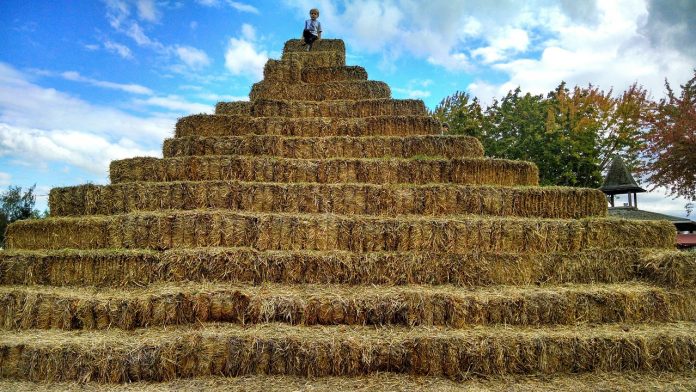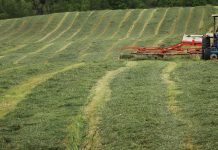Hay season is starting to wind down for the season with only one or two more cuttings left. As the hay and straw stacks grow, it’s important to inspect the stacks for stability as you add or remove bales.
There is an art to stacking hay no matter if they are small squares, round bales or large square bales of hay to ensure they remain stable during transport or storage.
Safety first
Despite your best stacking, hay will settle or shift over time, especially on uneven ground, causing the stack to lean. If the stack were to topple over, it could cause serious damage to surrounding buildings and equipment.
Hay bales are getting heavier and denser as baling technology advances. Dry round bales can weigh well over 1,000 pounds and the largest square bales are close to 2,000 pounds. This kind of weight can obviously damage equipment, but if one of these bales were to fall on a person it could be fatal.
When hay stacks fall, they don’t make much noise until the bales hit the ground. Unfortunately, this lack of noise catches people off guard especially if there is running equipment nearby.
Watch moving hay
Maintaining a solid stack of hay within barn walls is relatively easy compared to keeping a tight stack on a moving trailer or wagon. Every bump and bend in the road or field will settle and shift a stack of hay slightly.
The longer a distance the hay travels the more likely the stack will become unstable, which in turn increases the risk of injury for the person unloading the trailer. Ratchet straps can make a load of hay appear stable on a trailer, but may be hiding an unstable stack.
If you are buying western alfalfa or any hay that has traveled a long distance, take extra precautions when unloading. Never work alone, and — if possible — use equipment to stabilize the stack while unstrapping.
Don’t overload
I learned my hay stacking skills from my father-in-law who uses the “don’t worry about the mule, just load the wagon” approach. In his mind, you get the most hay on a wagon, take fewer trips back and forth and save space in the barn.
This approach works just fine until you find the weight limit of a wagon. It is not usually the running gear that determines the limit for a wagon, but rather the beams running between the axles. For a common 10-ton running gear, you can load about 10 large square bales or about 15 round bales before reaching the maximum weight.
I have seen and experienced broken wagon beds due to overloading. When a wagon fails it can suddenly dump a load of hay. On the road this can create a significant risk for other drivers, so it is important to inspect your wagons each season and stay within safe working load limits.
On the topic of safe working limits, it is also important to know the operating capacity of your skid loaders and tractors. While your spear may allow you to pick up three large square bales of hay, there is no guarantee all four tires are staying on the ground under that weight. There is also the very real risk that the top bale could fall back onto the cab or very expensive tractor hood, which is a risk to the operator and equipment.
Tips
As you move, stack and load hay follow these tips to stay safe:
• Stay within the safe operating capacity of your equipment. Lifting more weight than your skid steer or tractor is rated for can result in tipping or mechanical failure.
• Keep others safely out of your work area. Moving a hay stack can be like a game of Jenga where one wrong move could cause the stack to topple. If you are stacking hay on a trailer, make sure there is no one in your blind spot on the opposite side of the trailer.
• Unstable stacks should be restacked immediately. If you see the leaning tower of hay in your barn, take a moment to restack as soon as possible.
• Secure all loads of hay before traveling on roadways. Falling bales of hay introduce risks to others using the road.
• Never work alone when stacking or unloading hay.













